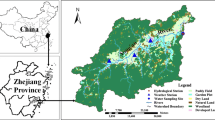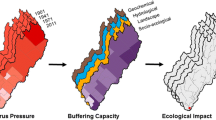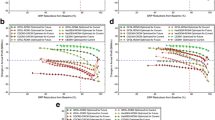Abstract
Decades of fertilizer and manure applications have led to a buildup of phosphorus (P) in agricultural soils and sediments, commonly referred to as legacy P. Legacy P can provide a long-term source of P to surface waters where it causes eutrophication. Using a suite of numerical models, we investigated the influence of legacy P on water quality in the Yahara Watershed of southern Wisconsin, USA. The suite included Agro-IBIS, a terrestrial ecosystem model; THMB, a hydrologic and nutrient routing model; and the Yahara Water Quality Model which estimates water quality indicators in the Yahara chain of lakes. Using five alternative scenarios of antecedent P storage (legacy P) in soils and channels under historical climate conditions, we simulated outcomes of P yield from the landscape, lake P loading, and three lake water quality indicators. Legacy P had a significant effect on lake loads and water quality. Across the five scenarios for Lake Mendota, the largest and most upstream lake, average P yield (kg ha−1) varied by −41 to +22%, P load (kg y−1) by −35 to +14%, summer total P (TP) concentration (mg l−1) by −25 to +12%, Secchi depth (m) by −7 to +3%, and the probability of hypereutrophy by −67 to +34%, relative to baseline conditions. The minimum storage scenario showed that a 35% reduction in present-day loads to Lake Mendota corresponded with a 25% reduction in summer TP and smaller reductions in the downstream lakes. Water quality was more vulnerable to heavy rainfall events at higher amounts of P storage and less so at lower amounts. Increases in heavy precipitation are expected with climate change; therefore, water quality could be protected by decreasing P reserves.









Similar content being viewed by others
REFERENCES
Andraski TW, Bundy LG. 2003. Relationships between phosphorus levels in soil and in runoff from corn production systems. J Environ Qual 32:310–16.
Ardón M, Morse JL, Doyle MW, Bernhardt ES. 2010. The Water Quality Consequences of Restoring Wetland Hydrology to a Large Agricultural Watershed in the Southeastern Coastal Plain. Ecosystems 13:1060–78.
Azevedo LB, van Zelm R, Leuven RSEW, Hendriks AJ, Huijbregts MAJ. 2015. Combined ecological risks of nitrogen and phosphorus in European freshwaters. Environ Pollut 200:85–92.
Bennett EM, Carpenter SR, Caraco NF. 2001. Human impact on erodable phosphorus and eutrophication: A global perspective. Bioscience 51:227–34.
Bennett EM, Carpenter SR, Clayton MK. 2004. Soil phosphorus variability: scale-dependence in an urbanizing agricultural landscape. Landsc Ecol 20:389–400.
Bennett EM, Reed-Andersen T, Houser JN, Gabriel JR, Carpenter SR. 1999. A phosphorus budget for the Lake Mendota Watershed. Ecosystems 2:69–75.
Bennett EM, Schipanski ME. 2013. The Phosphorus Cycle. In: Weathers KC, Strayer DL, Likens GE, editors. Fundamentals of Ecosystem Science. Waltham, MA: Elsevier. pp 159–78.
Bester ML, Frind EO, Molson JW, Rudolph DL. 2006. Numerical investigation of road salt impact on an urban wellfield. Ground Water 44:165–75.
Bilotta GS, Brazier RE, Haygarth PM. 2007. Processes affecting transfer of sediment and colloids, with associated phosphorus, from intensively farmed grasslands: erosion. Hydrol Process 21:135–9.
Bundy LG, Andraski TW, Powell JM. 2001. Management practice effects on phosphorus losses in runoff in corn production systems. J Environ Qual 30:1822–8.
Carlson RE. 1977. A trophic state index for lakes. Limnol Oceanogr 22:361–9.
Carpenter SR, Booth EG, Kucharik CJ, Lathrop RC. 2014. Extreme daily loads: role in annual phosphorus input to a north temperate lake. Aquat Sci 77:71–9.
Carpenter SR, Kitchell JF, Eds. 1993. The Trophic Cascade in Lakes. Cambridge, England: Cambridge University Press. p 385.
Carpenter SR, Lathrop RC. 2014. Phosphorus loading, transport and concentrations in a lake chain: a probabilistic model to compare management options. Aquat Sci 76:145–54.
Carpenter SR, Lathrop RC, Nowak P, Bennett EM, Reed T, Soranno PA. 2006. The ongoing experiment: restoration of Lake Mendota and its watershed. In: Magnuson JJ, Kratz TK, Benson BJ, editors. Long-term dynamics of lakes in the landscape. London: Oxford University Press. pp 236–56.
Chen Y, Liu R, Sun C, Zhang P, Feng C, Shen Z. 2012. Spatial and temporal variations in nitrogen and phosphorous nutrients in the Yangtze River Estuary. Mar Pollut Bull 64:2083–9.
Childers DL, Corman J, Edwards M, Elser JJ. 2011. Sustainability Challenges of Phosphorus and Food: Solutions from Closing the Human Phosphorus Cycle. Bioscience 61:117–24.
Coe MT. 1998. A linked global model of terrestrial hydrologic processes: Simulation of modern rivers, lakes, and wetlands. J Geophys Res 103:8885–99.
Coe MT. 2000. Modeling Terrestrial Hydrological Systems at the Continental Scale: Testing the Accuracy of an Atmospheric GCM. J Clim 13:686–704.
Coe MT, Costa MH, Howard EA. 2008. Simulating the surface waters of the Amazon River basin: impacts of new river geomorphic and flow parameterizations. Hydrol Process 22:2542–53.
Dai Z, Du J, Zhang X, Su N, Li J. 2010. Variation of Riverine Material Loads and Environmental Consequences on the Changjiang (Yangtze) Estuary in Recent Decades (1955–2008). Environ Sci Technol 45:223–7.
Donner SD, Coe MT, Lenters JD, Twine TE, Foley JA. 2002. Modeling the impact of hydrological changes on nitrate transport in the Mississippi River Basin from 1955 to 1994. Global Biogeochem Cycles 16:1–19.
Dubrovsky NM, Burow KR, Clark GM, Gronberg JM, Hamilton PA, Hitt KJ, Mueller DK, Munn MD, Nolan BT, Puckett LJ, Others. 2010. The quality of our Nation’s waters-Nutrients in the Nation’s streams and groundwater, 1992–2004. US Geological Survey Circular 1350. http://pubs.usgs.gov/circ/1350/.
Edwards AC, Withers PJA. 1998. Soil phosphorus management and water quality: a UK perspective. Soil Use Manage 14:124–30.
El Maayar M, Price DT, Delire C, Foley JA, Black TA, Bessemoulin P. 2001. Validation of the Integrated Biosphere Simulator over Canadian deciduous and coniferous boreal forest stands. J Geophys Res 106:14339.
Elser J, Bennett E. 2011. Phosphorus cycle: A broken biogeochemical cycle. Nature 478:29–31.
Foley JA, Prentice IC, Ramankutty N, Levis S, Pollard D, Sitch S, Haxeltine A. 1996. An integrated biosphere model of land surface processes, terrestrial carbon balance, and vegetation dynamics. Global Biogeochem Cycles 10:603–28.
Genskow K, Rumery Betz C. 2012. Farm Practices in the Lake Mendota Watershed: A Comparative Analysis of 1996 and 2011.
Gillon S, Booth EG, Rissman AR. 2016. Shifting drivers and static baselines in environmental governance: challenges for improving and proving water quality outcomes. Regional Environ Change 16:759–75.
Hamilton SK. 2012. Biogeochemical time lags may delay responses of streams to ecological restoration. Freshw Biol 57:43–57.
Haygarth PM, Jarvie HP, Powers SM, Sharpley AN, Elser JJ, Shen J, Peterson HM, Chan N-I, Howden NJK, Burt T, Worrall F, Zhang F, Liu X. 2014. Sustainable phosphorus management and the need for a long-term perspective: the legacy hypothesis. Environ Sci Technol 48:8417–19.
Horrocks CA, Dungait JAJ, Cardenas LM, Heal KV. 2014. Does extensification lead to enhanced provision of ecosystems services from soils in UK agriculture? Land Use Policy 38:123–8.
James LA. 2013. Legacy sediment: definitions and processes of episodically produced anthropogenic sediment. Anthropocene 2:16–26.
Jarvie HP, Sharpley AN, Spears B, Buda AR, May L, Kleinman PJA. 2013a. Water quality remediation faces unprecedented challenges from ‘legacy phosphorus’. Environ Sci Technol 47:8997–8.
Jarvie HP, Sharpley AN, Withers PJA, Scott JT, Haggard BE, Neal C. 2013b. Phosphorus mitigation to control river eutrophication: Murky waters, inconvenient truths, and ‘postnormal’ science. J Environ Qual 42:295–304.
Kahiluoto H, Kuisma M, Ketoja E, Salo T, Heikkinen J. 2015. Phosphorus in manure and sewage sludge more recyclable than in soluble inorganic fertilizer. Environ Sci Technol 49:2115–22.
Kara EL, Heimerl C, Killpack T, Van de Bogert MC, Yoshida H, Carpenter SR. 2011. Assessing a decade of phosphorus management in the Lake Mendota, Wisconsin watershed and scenarios for enhanced phosphorus management. Aquat Sci 74:241–53.
Kleinman PJA, Sharpley AN, Saporito LS, Buda AR, Bryant RB. 2008. Application of manure to no-till soils: phosphorus losses by sub-surface and surface pathways. Nutr Cycling Agroecosyst 84:215–27.
Kleinman PJA, Srinivasan MS, Dell CJ, Schmidt JP, Sharpley AN, Bryant RB. 2006. Role of rainfall intensity and hydrology in nutrient transport via surface runoff. J Environ Qual 35:1248–59.
Kucharik CJ. 2003. Evaluation of a process-based agro-ecosystem model (Agro-IBIS) across the U.S. Corn Belt: Simulations of the interannual variability in maize yield. Earth Interact 7:1–33.
Kucharik CJ, Barford CC, Maayar ME, Wofsy SC, Monson RK, Baldocchi DD. 2006. A multiyear evaluation of a dynamic global vegetation model at three AmeriFlux forest sites: Vegetation structure, phenology, soil temperature, and CO2 and H2O vapor exchange. Ecol Modell 196:1–31.
Kucharik CJ, Brye KR. 2003. Integrated BIosphere Simulator (IBIS) yield and nitrate loss predictions for Wisconsin maize receiving varied amounts of nitrogen fertilizer. J Environ Qual 32:247–68.
Kucharik CJ, Foley JA, Delire C, Fisher VA, Coe MT, Lenters JD, Young-Molling C, Ramankutty N, Norman JM, Gower ST. 2000. Testing the performance of a dynamic global ecosystem model: Water balance, carbon balance, and vegetation structure. Global Biogeochem Cycles 14:795–825.
Kucharik CJ, Twine TE. 2007. Residue, respiration, and residuals: Evaluation of a dynamic agroecosystem model using eddy flux measurements and biometric data. Agric For Meteorol 146:134–58.
Lathrop RC. 2007. Perspectives on the eutrophication of the Yahara lakes. Lake Reserv Manag 23:345–65.
Lathrop RC, Carpenter SR. 2013. Water quality implications from three decades of phosphorus loads and trophic dynamics in the Yahara chain of lakes. Inland Waters 4:1–14.
Lathrop RC, Carpenter SR, Stow CA, Soranno PA, Panuska JC. 1998. Phosphorus loading reductions needed to control blue-green algal blooms in Lake Mendota. Can J Fish Aquat Sci 55:1169–78.
MA (Millenium Ecosystem Assessment). 2005. Ecosystems and human well-being: summary for decision makers. Washington D.C.: Island Press.
McCollum RE. 1991. Buildup and decline in soil phosphorus: 30-year trends on a typical Umprabuult. Agron J 83:77–85.
Meals DW, Dressing SA, Davenport TE. 2010. Lag time in water quality response to best management practices: a review. J Environ Qual 39:85–96.
Metson GS, MacDonald GK, Haberman D, Nesme T, Bennett EM. 2015. Feeding the Corn Belt: Opportunities for phosphorus recycling in U.S. agriculture. Sci Total Environ 542:1117–26.
Nowak P, Shepard R, Madison F, Hatfield JL, Stewart BA, Others. 1998. Farmers and manure management: a critical analysis. In: Hatfield JL, Stewart BA, editors. Animal Waste Utilization: Effective use of manure as a soil resource. Lewis Publishers. pp 1–32.
Owens PN, Walling DE. 2002. The phosphorus content of fluvial sediment in rural and industrialized river basins. Water Res 36:685–701.
Page T, Haygarth PM, Beven KJ, Joynes A, Butler T, Keeler C, Freer J, Owens PN, Wood GA. 2005. Spatial variability of soil phosphorus in relation to the topographic index and critical source areas. J Environ Qual 34:2263–77.
Powers SM, Bruulsema TW, Burt TP, Chan NI, Elser JJ, Haygarth PM, Howden NJK, Jarvie HP, Lyu Y, Peterson HM, Sharpley AN, Shen J, Worrall F, Zhang F. 2016. Long-term accumulation and transport of anthropogenic phosphorus in three river basins. Nat Geosci 9(5):353–6.
Reed-Andersen T, Carpenter SR, Lathrop RC. 2000. Phosphorus flow in a watershed-lake ecosystem. Ecosystems 3:561–73.
Rissman AR, Carpenter SR. 2015. Progress on nonpoint pollution: Barriers & opportunities. Daedalus 144:35–47.
Rowe H, Withers PJA, Baas P, Chan NI, Doody D, Holiman J, Jacobs B, Li H, MacDonald GK, McDowell R, Sharpley AN, Shen J, Taheri W, Wallenstein M, Weintraub MN. 2015. Integrating legacy soil phosphorus into sustainable nutrient management strategies for future food, bioenergy and water security. Nutr Cycling Agroecosyst:1–20.
Sattari SZ, Bouwman AF, Giller KE, van Ittersum MK. 2012. Residual soil phosphorus as the missing piece in the global phosphorus crisis puzzle. Proc Natl Acad Sci U S A 109:6348–53.
Schulte RPO, Melland AR, Fenton O, Herlihy M, Richards K, Jordan P. 2010. Modelling soil phosphorus decline: Expectations of Water Framework Directive policies. Environ Sci Policy 13:472–84.
Scott CA, Walter MF, Nagle GN, Todd Walter M, Sierra NV, Brooks ES. 2001. Residual phosphorus in runoff from successional forest on abandoned agricultural land: 1. Biogeochemical and hydrological processes. Biogeochemistry 55:293–310.
Sharpley A. 2016. Managing agricultural phosphorus to minimize water quality impacts. Sci Agric 73:1–8.
Sharpley A, Jarvie HP, Buda A, May L, Spears B, Kleinman P. 2013. Phosphorus legacy: overcoming the effects of past management practices to mitigate future water quality impairment. J Environ Qual 42:1308–26.
Sharpley AN, Chapra SC, Wedepohl R, Sims JT, Daniel TC, Reddy KR. 1994. Managing agricultural phosphorus for protection of surface waters - issues and options. J Environ Qual 23:437–51.
Shigaki F, Sharpley A, Prochnow LI. 2007. Rainfall intensity and phosphorus source effects on phosphorus transport in surface runoff from soil trays. Sci Total Environ 373:334–43.
Smith DR, Warnemuende-Pappas EA. 2015. Vertical tillage impacts on water quality derived from rainfall simulations. Soil Tillage Res 153:155–60.
Smith VH, Joye SB, Howarth RW. 2006. Eutrophication of freshwater and marine ecosystems. Limnol Oceanogr 51:351–5.
Soranno PA, Hubler SL, Carpenter SR, Lathrop RC. 1996. Phosphorus loads to surface waters: a simple model to account for spatial pattern of land use. Ecol Appl 6:865–78.
Soylu ME, Kucharik CJ, Loheide II, Steven P. 2014. Influence of groundwater on plant water use and productivity: Development of an integrated ecosystem – Variably saturated soil water flow model. Agric For Meteorol 189–190:198–210.
Staver KW, Brinsfield RB. 2001. Agriculture and water quality on the Maryland eastern shore: Where do we go from here? Bioscience 51:859–68.
Stigliani WM, Doelman P, Salomons W, Schulin R, Smidt GRB, der Zee SEATMV. 1991. Chemical time bombs: Predicting the unpredictable. Environment 33:4–30.
Stumborg BE, Baerenklau KA, Bishop RC. 2001. Nonpoint source pollution and present values: A contingent valuation study of Lake Mendota. Rev Agric Econ 23:120–32.
Sturgul SJ, Bundy LG. 2004. Understanding Soil Phosphorus. University of Wisconsin-Extension http://ipcm.wisc.edu/download/pubsNM/UnderstandingSoilP04.pdf.
The MathWorks, Inc. 2015. MATLAB and Statistics Toolbox. Natick Massachusetts, USA: The MathWorks Inc.
Trenberth KE. 2011. Changes in precipitation with climate change. Clim Res 47:123–38.
Vadas PA, Gburek WJ, Sharpley AN, Kleinman PJA, Moore PA Jr, Cabrera ML, Harmel RD. 2007. A model for phosphorus transformation and runoff loss for surface-applied manures. J Environ Qual 36:324–32.
Vadas PA, Haggard BE, Gburek WJ. 2005. Predicting dissolved phosphorus in runoff from manured field plots. J Environ Qual 34:1347–53.
Vadas PA, Kleinman PJA, Sharpley AN. 2004. A simple method to predict dissolved phosphorus in runoff from surface-applied manures. J Environ Qual 33:749–56.
Vadas PA, White MJ. 2010. Validating Soil Phosphorus Routines in the SWAT Model. Transactions of the ASABE 53:1469–76.
Van Meter KJ, Basu NB, Veenstra JJ, Burras CL. 2016. The nitrogen legacy: emerging evidence of nitrogen accumulation in anthropogenic landscapes. Environ Res Lett 11(3):1–12.
Walling DE, Collins AL, Stroud RW. 2008. Tracing suspended sediment and particulate phosphorus sources in catchments. J Hydrol 350:274–89.
Walsh JR, Carpenter SR, Vander Zanden MJ. 2016. Invasive species triggers a massive loss of ecosystem services through a trophic cascade. Proc Natl Acad Sci U S A . doi:10.1073/pnas.1600366113.
Wang Y, Zhang X, Huang C. 2009. Spatial variability of soil total nitrogen and soil total phosphorus under different land uses in a small watershed on the Loess Plateau, China. Geoderma 150:141–9.
Wardropper CB, Chang C, Rissman AR. 2015. Fragmented water quality governance: Constraints to spatial targeting for nutrient reduction in a Midwestern USA watershed. Landsc Urban Plan 137:64–75.
Water Resources Management Practicum. 2015. Assessment of transient sediment in the six-mile creek watershed. https://www.nelson.wisc.edu/docs/WRM2013_report.pdf.
WICCI. 2011. Wisconsin’s Changing Climate: Impacts and Adaptation. Wisconsin Initiative on Climate Change Impacts. Nelson Institute for Environmental Studies, University of Wisconsin-Madison and the Wisconsin Department of Natural Resources, Madison, Wisconsin.
Wilfert P, Kumar PS, Korving L, Witkamp G-J, van Loosdrecht MCM. 2015. The relevance of phosphorus and iron chemistry to the recovery of phosphorus from wastewater: A review. Environ Sci Technol 49:9400–14.
Withers PJA, Edwards AC, Foy RH. 2001. Phosphorus cycling in UK agriculture and implications for phosphorus loss from soil. Soil Use Manage 17:139–49.
Wolfe ML, Ting KC, Scott N, Sharpley AN, Jones JW, Verma L. 2016. Engineering solutions for food-energy-water systems: it is more than engineering. J Environ Stud Sci 6:172–82.
Zipper SC, Soylu ME, Booth EG, Loheide SPII. 2015. Untangling the effects of shallow groundwater and soil texture as drivers of subfield-scale yield variability. Water Resour Res 51:6338–58.
Acknowledgements
This material is based upon work supported by the National Science Foundation under Grant No. DEB-1038759.
Author information
Authors and Affiliations
Corresponding author
Additional information
Author contributions
XC and MM designed the study. MM, XC, SRC, and PP conducted model simulations. MM analyzed the data. All authors contributed to either new methods, models, or supporting data. MM, XC, EB, SRC, PP, and SZ wrote the first draft, and all authors contributed to the final draft.
This article contains a supporting appendix that is available online at https://github.com/mmotew/Appendix-Motew-et-al-2017.git.
Electronic supplementary material
Below is the link to the electronic supplementary material.
Rights and permissions
About this article
Cite this article
Motew, M., Chen, X., Booth, E.G. et al. The Influence of Legacy P on Lake Water Quality in a Midwestern Agricultural Watershed. Ecosystems 20, 1468–1482 (2017). https://doi.org/10.1007/s10021-017-0125-0
Received:
Accepted:
Published:
Issue Date:
DOI: https://doi.org/10.1007/s10021-017-0125-0




